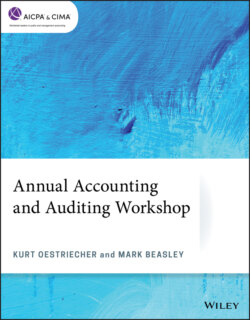Читать книгу Annual Accounting and Auditing Workshop - Kurt Oestriecher - Страница 10
На сайте Литреса книга снята с продажи.
What are the main provisions of this ASU?
ОглавлениеThe amendments in this update provide guidance on the following eight specific cash flow issues:
Issue 1: Debt Prepayment or Debt Extinguishment Costs. Cash payments for debt prepayment or debt extinguishment costs should be classified as cash outflows for financing activities.
Issue 2: Settlement of Zero-Coupon Debt Instruments. At the settlement of zero-coupon debt instruments (or other debt instruments with coupon interest rates that are insignificant in relation to the effective interest rate of the borrowing), the cash flows must be split into operating and financing activities. The portion of the cash payment attributable to the accreted interest should be classified as operating activities and the portion attributable to the principal as cash outflows for financing activities.
Issue 3: Contingent Consideration Payments Made after a Business Combination. Cash payments made soon after the acquisition date of a business combination to settle a contingent consideration liability should be classified as cash outflows for investing activities.
Cash payments for contingent consideration that were not made soon after the acquisition date of a business combination should be separated and classified as cash outflows for financing activities and operating activities. Cash payments up to the amount of the contingent consideration liability recognized at the acquisition date (including measurement-period adjustments) should be classified as financing activities; any excess should be classified as operating activities. Cash payments made soon after the acquisition date of a business combination by an acquirer to settle a contingent consideration liability should be classified as cash outflows for investing activities.
Note that the Emerging Issues Task Force specifically decided not to set a time frame for the term “soon after.” However, some task force members believe that a payment made within a relatively short period of time after the acquisition date (for example, three months or less), would qualify as “soon after.” (paragraph BC 16).
Issue 4: Proceeds from the Settlement of Insurance Claims. Cash proceeds received from the settlement of insurance claims should be classified on the basis of the nature of the loss. For insurance proceeds that are received in a lump-sum settlement, an entity should determine the classification on the basis of the nature of each loss included in the settlement.
Issue 5: Proceeds from the Settlement of Corporate-Owned (or Bank-Owned) Life Insurance Policies. Cash proceeds received from the settlement of corporate-owned life insurance policies should be classified as cash inflows from investing activities. The cash payments for premiums on corporate-owned policies may be classified as cash outflows for investing activities, operating activities, or a combination of investing and operating activities.
Issue 6: Distributions Received from Equity Method Investees. When a reporting entity applies the equity method, it should make an accounting policy election to classify distributions received from equity method investees using either of the following approaches:
1 Cumulative earnings approach: Distributions received are considered returns on investment and therefore are classified as inflows from operating activities. However, if the cumulative distributions received less distributions received in prior periods that were determined to be returns of investment exceed cumulative equity in earnings recognized by the investor, the excess is considered to be a return of investment and is classified as cash inflows from investing activities.
2 Nature of the distribution approach: Distributions received should be classified on the basis of the nature of the activity or activities of the investee that generated the distribution as either a return on investment (classified as cash inflows from operating activities) or a return of investment (classified as cash inflows from investing activities) when such information is available to the investor.
If an entity elects to apply the nature of the distribution approach and the information to apply that approach to distributions received from an individual equity method investee is not available to the investor, the entity must apply the cumulative earnings approach, and report a change in accounting principle on a retrospective basis. The entity must disclose that a change in accounting principle has occurred due to the lack of available information and should provide the disclosures required in paragraphs 250-10-50-1(b) and 250-10-50-2, as applicable.
This amendment does not address equity method investments measured using the fair value option.
Issue 7: Beneficial Interests in Securitization Transactions. A transferor’s beneficial interest received in a securitization of financial assets should be disclosed as a noncash activity. Subsequent cash receipts from payments on a beneficial interest in securitized trade receivables should be classified as cash inflows from investing activities.
Issue 8: Separately Identifiable Cash Flows and Application of the Predominance Principle. For cash receipts and payments that have aspects of more than one class of cash flows, the following three-step approach should be followed:
1 An entity should first apply specific guidance in GAAP.
2 If there is no specific guidance, an entity should determine each separately identifiable source or use within the cash receipts and cash payments on the basis of the nature of the underlying cash flows. Each separately identifiable source or use will then be classified as operating, investing, or financing by applying the guidance in ASC 230.
3 In situations in which cash receipts and payments cannot be separated by source or use, the appropriate classification should depend on the activity that is likely to be the predominant source or use of cash flows for the item.
